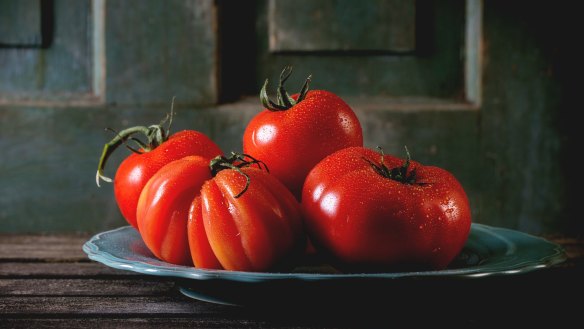True or false: Bright red tomatoes have more nutrients than pale ones?

Do bright red tomatoes with flavour have more nutrients than pale bland ones? L. Johnson
"Never eat tomatoes from the end of autumn until the first of the new season's crop in summer," an old Italian neighbour used to tell me.
"A tomato should fill your face with aroma," she said. "When it gets cold you should only be eating tinned or bottled tomatoes in your sugo for pasta."
A ripe, aromatic tomato is packed with phytonutrients, compounds that fruit and vegetables have evolved to naturally produce to protect themselves against pest attack. Funnily enough, we have evolved to find many of these ingredients not only attractive but delicious. Lycopene is a carotenoid and is the compound that makes tomatoes red. It also colours pink grapefruit pink and watermelon red. Populations with high levels of consumption of lycopene have been associated with decreased occurrence of certain cancers.
The average Australian eats 3.8mg of lycopene a day while the average Italian consumes double this. But before you start popping lycopene pills from the Placebo Warehouse (and before I start sounding like Pete Evans), research shows that the best health outcomes are achieved by populations who eat a broad range of different coloured fruits and vegetables.
Best way to peel chestnuts? J. Thompson
I remember writing about chestnuts for a rival publication years ago. Back then I assumed all people knew to score their chestnuts before cooking. One furious reader wanted me to replace her microwave because it was covered in chestnut pulp as they exploded inside her treasured Sanyo. I glibly offered her instead some detergent and a bristle brush.
Ultra fresh chestnuts don't peel easily so if you have a chestnut tree, dry them flat in a warm airy place for a few days. They should give just a little when squeezed. Chestnuts needs to be scored with a sharp knife: a small vegetable knife is perfect.
Simmer them in water for 15 minutes or so, remove one at a time and peel while hot. Roast at 180C for 20 minutes or microwave on high for 5 minutes. Use a vegetable knife and remove outer husk. The skin of some varieties will come away with a dry cloth, other varieties may need to be scraped with a knife.
Once peeled use to thicken soups, or chop and add to stir-fried cabbage and speck dressed with maple syrup and cider vinegar. For sweets, cook in light sugar syrup and serve with cream.
Letters, Corrections and Apologies
Lovely to have a global readership and receive their random missives, such as this from M. Lewis. "Here in Wales," they write, "rissoles are made with a tin of corned beef, potatoes boiled, onion and mixed herbs. Blend together." I tried this and it was surprisingly delicious in a school cadet camp kind of way.
Send your vexing culinary conundrums to brainfood@richardcornish.com.au or tweet to @Foodcornish.
